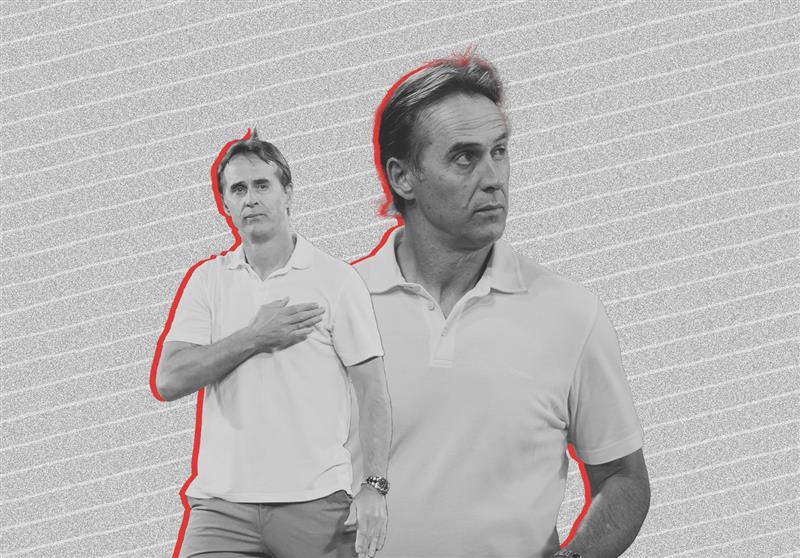Julen Lopetegui’s golden era at Sevilla is over. The man who took the club into the Champions League knockout stage and won a Europa League title, beating Manchester United and Inter Milan along the way, has been relieved of his duties.
For a brief, wonderful moment, Lopetegui let the Sevilla fans dream of a LaLiga title challenge.
His sacking shouldn’t be viewed as a failure though. Sevilla flew too close to the sun under Lopetegui and given their strict economic policy and wage structure, they have to retreat now and think about the longer term future of the club.
“The people have to understand that we have achieved our main objective,” Fernando Reges said at the end of last season. “There is a Sevilla before and another one post-Lopetegui. Before Lopetegui, Sevilla were fighting to get into Europe. Now, the fans want Champions League and to win LaLiga.”
In all three seasons of his tenure, Seville made the Champions League, finishing fourth in the league each year behind only Spain’s ‘big three’. He turned Jules Kounde and Diego Carlos into the most feared centre-back partnership in Spain and they played some of the most elaborate football in Europe. Under Lopetegui, Sevilla were a force to be reckoned with.
To understand why Lopetegui needed this spell at Sevilla and now needs to be remembered for what he did at the club instead of what he didn’t do, you have to go back to the start. After guiding Spain to the 2018 World Cup, he was unceremoniously sacked by Spanish football federation president Luis Rubiales after news broke that Lopetegui had agreed to become the new Real Madrid manager after the tournament.
“Yesterday was the worst day of my life since my mother passed away,” Lopetegui said at the press conference announcing him as the new Real Madrid manager. It was hard not to believe him such was the look on his non-shaven face as he got off the plane from Russia and landed in Barajas airport in Madrid the day after being relieved of his duties as Spain manager. The man was distraught.
“But today is the happiest,” he continued beside a smiling Florentino Perez.
Lopetegui assumed his new role as the manager of Real Madrid and was sacked unceremoniously, yet again, 14 games later. The club had sold Cristiano Ronaldo and didn’t replace him, but Lopetegui was the fall guy. Dani Carvajal said he’s ‘the best coach I ever had’ and you could see in his Spain team that he had a clear idea about how he wanted to play. That didn’t matter in the result-driven environment of the Santiago Bernabeu.
At Sevilla, it was different. Here was a club proud to have him. The sporting director, Monchi, knows a coup when he sees one and Lopetegui had fallen on hard times, sure, but there was a reason Real Madrid wanted him in the first place and a reason why Spain were one of the favourites going into the World Cup in Russia.
Monchi and Lopetegui’s mentality’s seemed a perfect match; technicians obsessed with the details of their craft. Monchi, a former goalkeeper himself, just like Lopetegui, didn’t achieve his status on the back of his playing career. It was hard-earned and they both understood what is was like to live on the precipice when you’re name can’t and won’t act as a harness if you slip.
And for three years, the pairing worked. A club, manager and sporting director with matching ambitions and shared goals.
What Went Wrong for Lopetegui at Sevilla?
The problems started last season when Sevilla went from competing with Real Madrid for LaLiga to struggling to hold on to fourth place. They were second in the table until matchday 29 last year and then it slowly started to unravel. Injuries and poor finishing cost them.
They would eventually draw 16 times in La Liga last season including four of their last five before a win against Athletic Club on the final day of the season. They lost four times, the same amount as eventual champions Madrid, but their 16 draws were double that of Atlético Madrid and Real Betis, the two teams above and below them in LaLiga.
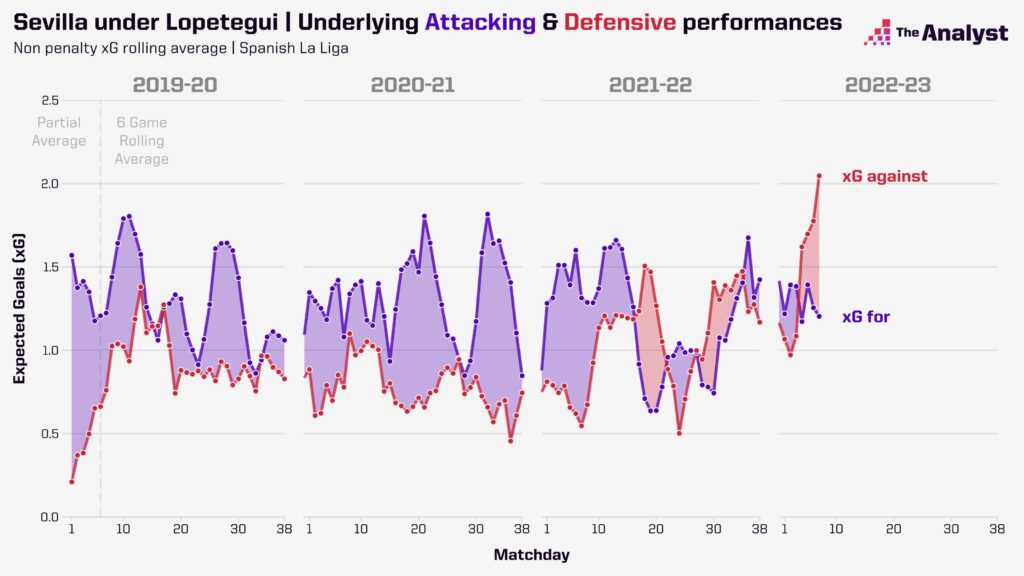
Fernando missed the end of last season with an ankle injury, a classic Monchi coup who turned into one of the best players in the team. Suso didn’t play a game after November last season. Papu Gomez missed time during that wretched spell that derailed Sevilla’s season and Jesus Navas battled injuries all season too. For a team pushing beyond its the boundaries of its perceived capabilities, a list of injuries as long as Sevilla had last season can have a devastating effect.
This season, Lopetegui’s luck on the injury front hasn’t seemed to change. One game in, in the middle of August, Tecatito Corona broke his leg in training, leaving him out injured until after the World Cup. A club already lacking inspiration and creativity had just lost one of their best dribblers and someone who could unlock defences.
Lopetegui’s style of play is high-pressing, high-risk passing out from the back. There were constantly at the top of the PPDA chart under Lopetegui. They wanted the ball and they were going to hurt you once they won it back. They wouldn’t hurt you with lethal incision but slow and elaborate passing, sending you backwards with back and fourth across the field until they were laying assault to your penalty area.
A video of one of Sevilla’s goals went viral last season. It was sublime. A move that consisted of 37 passes that ended in a Luuk de Jong goal. Pure Lopetegui.
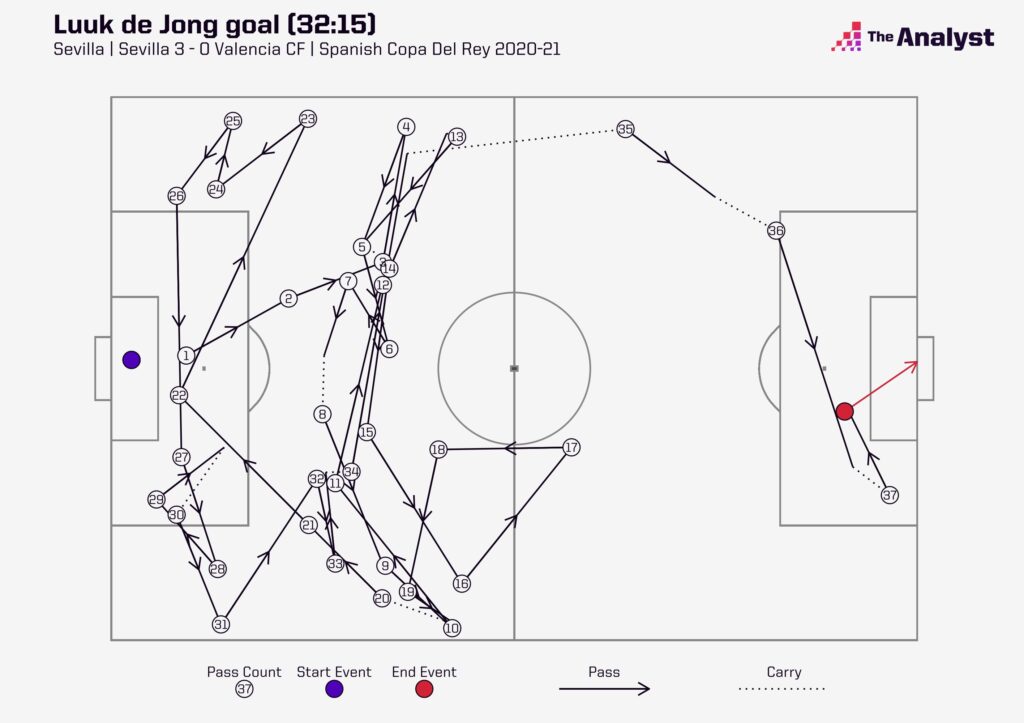
This was a team that loved to build slow and intricate moves that wore out the opposition and prevented them from having the ball. But this season, intricate became laboured. The slowness belied uncertainty. There was no clarity in their chance creation and the players tasked with finishing off the chances they did create couldn’t. More often than not they started hoofing it forward to get it away from their own goal. Anathema to Lopetegui’s liking but necessary.
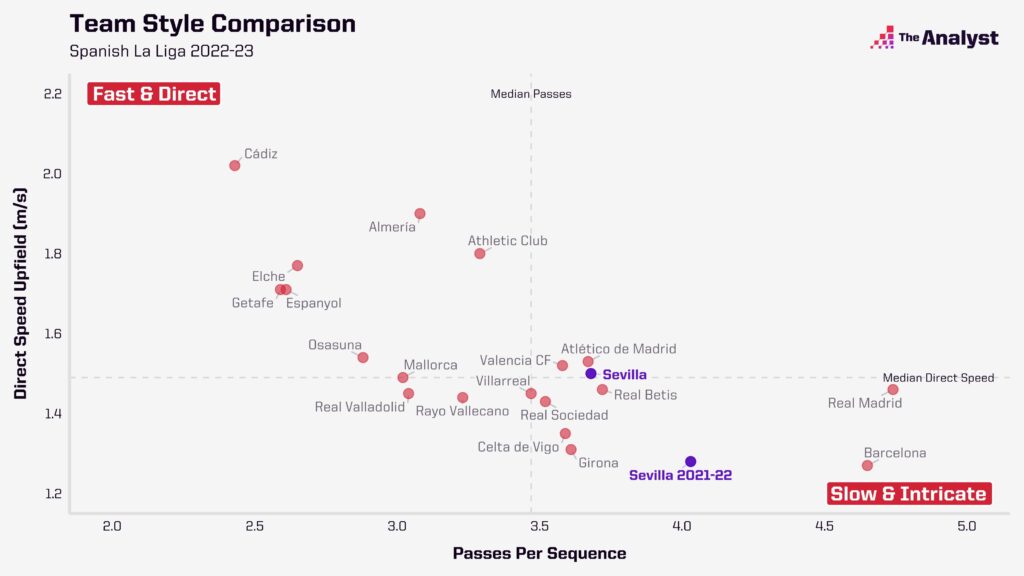
The goals issue has long-existed for Lopetegui. It was levelled at him during his Spain spell and it cost him his job at Real Madrid. The same can be said of his time in Seville. But each time, there have been mitigating circumstances. Spain have struggled for goals forever. Real Madrid sold Ronaldo the season he arrived and Monchi has never been able to provide Lopetegui with the number nine his style needs.
It is no surprise that Jorge Sampaoli, the manager who has taken over from Lopetegui, reportedly asked for reinforcements up front in the winter transfer market as part of the demands to take the job. Sevilla have been crying out for a world class number nine now for a couple of seasons.
Rafa Mir, the former Wolves striker has only scored once this season. Youssef En-Nesyri hadn’t scored until Lopetegui’s last game in charge on Wednesday night – a consolation against Borussia Dortmund. Kasper Dolberg, a late summer recruit, has only recently been given minutes and hasn’t scored yet either. Their joint-top scorer this season is Jose Carmona, a central defender in his debut season, along with Oliver Torres. They both have two goals.
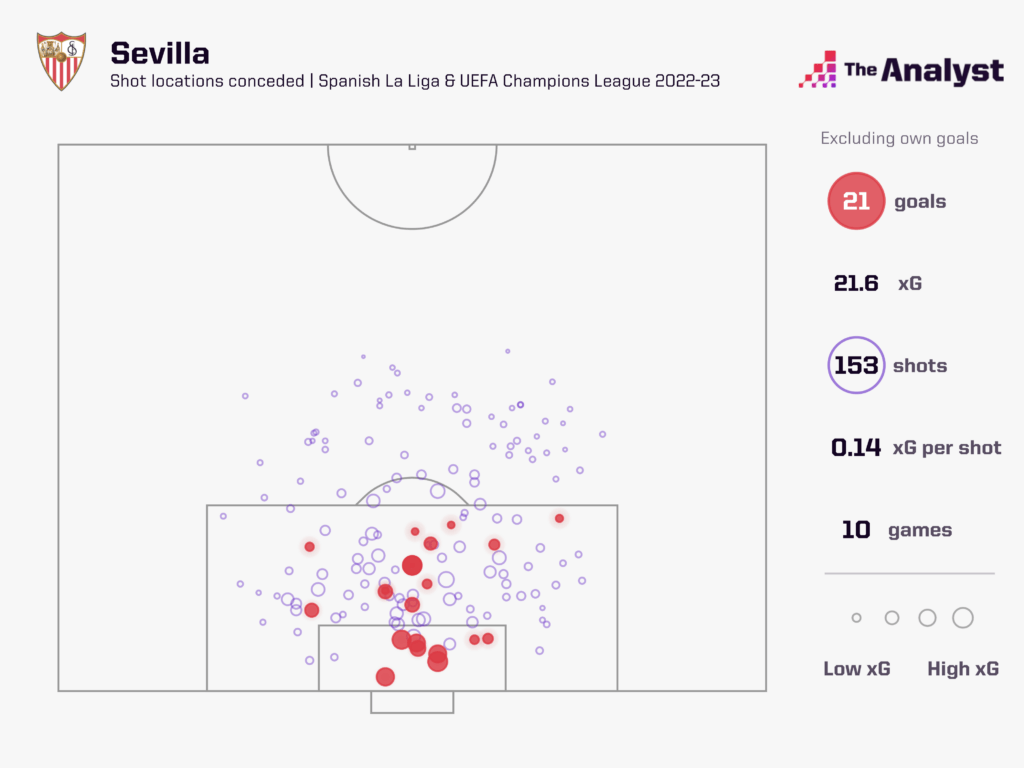
But even last season, Sevilla had been struggling for goals. Only one player hit double digits last year for them — Rafa Mir with 10. After that, Lucas Ocampos scored six. If you expand that to all competitions, Rafa Mir is the leader with 13 and Ocampos scored nine.
The chance creation and chance-taking is one thing but their defense suffered a monumental collapse this season too. They are currently in relegation contender-form in both xG for and xG against. Their xG difference after seven games has them in the bottom third.
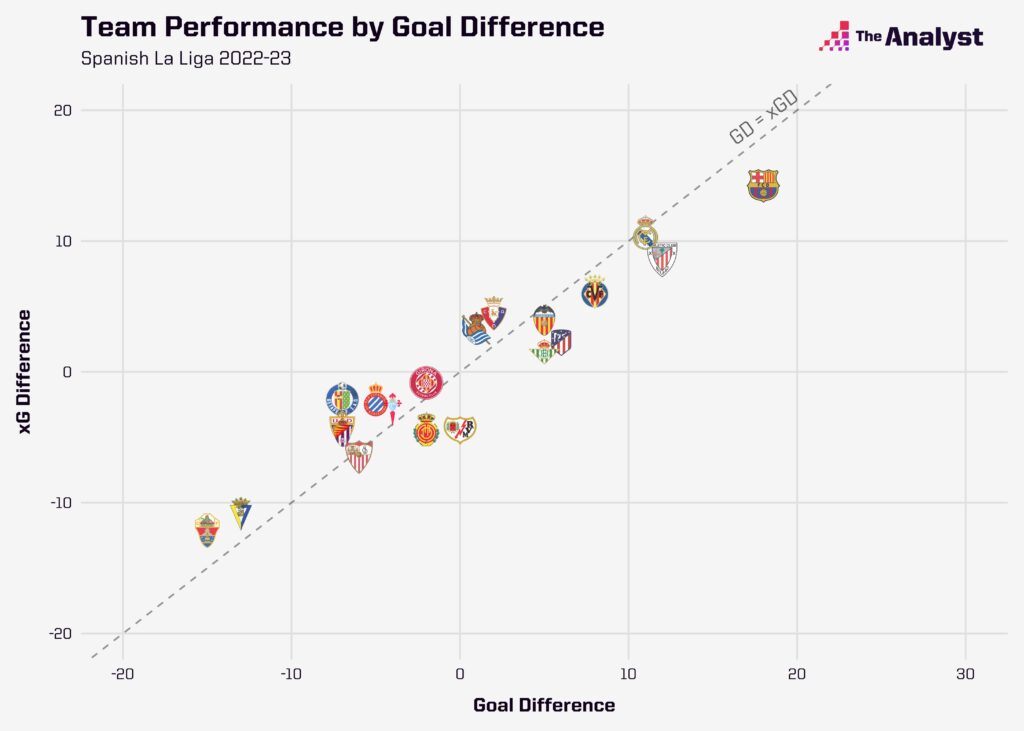
The reasons for that are quite obvious. Sevilla continued their sell-high policy this summer by selling Jules Kounde to Barcelona and Diego Carlos to Aston Villa; two players who finished first and third respectively in minutes played last season. In second place on that list was Bono, the goalkeeper. The triangle of solidity at the back sold in one summer. They formed part of the stingiest defences in LaLiga and Europe while together and they were never left out.
Where Kounde and Carlos once prowled, Sevilla now have a revolving cast of youngsters and unproven veterans. They can’t build-up play properly, in the way Lopetegui wants them to, because they can’t take any risks at the back. Every time the ball is given away, Sevilla look like conceding.
Last season, they had the meanest defence in the league, conceding just 30 goals in 38 games. This season they have already conceded 13 and on pace to concede over 70.
Lopetegui has had to alter his approach this season. The PPDA is still one of the highest in the top five European leagues and only Valencia, Barcelona and Liverpool have allowed fewer passes against them this season. Bu their 7.4 high turnovers a game is just above average amongst all teams in the Europe’s top leagues (7.3). When you press without success, you’re in big trouble.
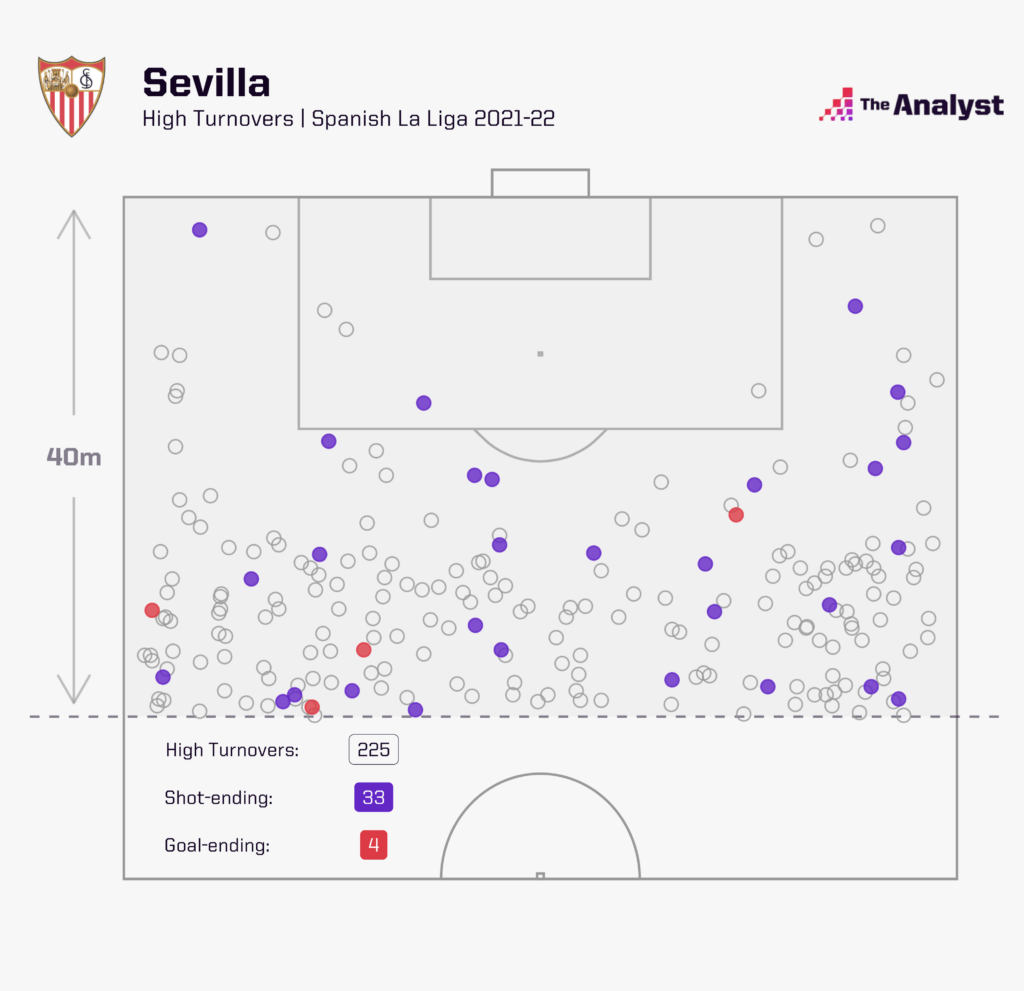
He has given debuts to Kike Salas, Tanguy Nianzou, two of the youngest debutants in LaLiga this season. He has also given a debut to Alex Telles and is waiting for one of the only summer signings who might have been able to help his ailing defense in Marcao, signed from Turkey giants Galatasaray, to recover from injury. Another player, Jose Carmona, who played one LaLiga match prior to this season has emerged as a leader at the back. He has played eight games, scoring twice and providing an assist for another.
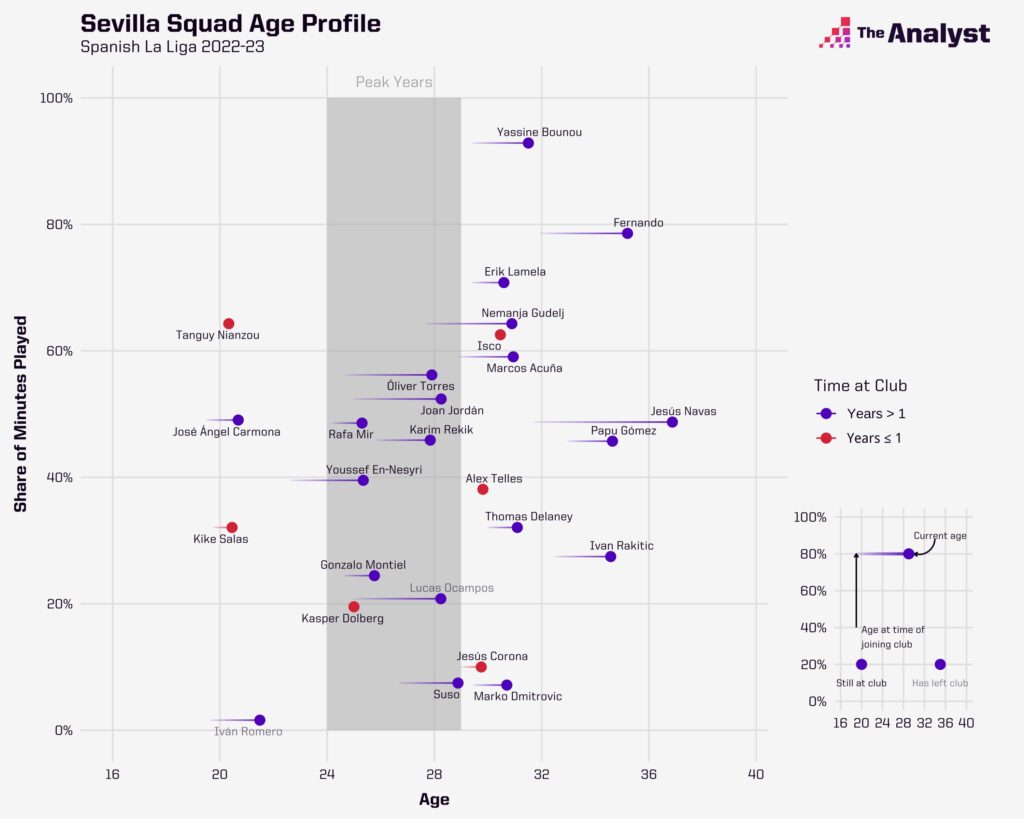
They have conceded 82 shots this season – the third most in LaLiga with an xG of 11.27, which is the second highest in LaLiga.
“I won’t offer my opinion about what has happened in recent months due to my primary responsibility as the coach of Sevilla,” Lopetegui said before his final game as the manager of the club. He had been ‘sentenced’ as they say in Spain and everyone was aware, including himself.
“They don’t just gift you 170 games as the manager of a club like Sevilla,” he said as a reminder of the success he had at the club. Lopetegui was defiant but hurt. He sounded haunted by the thought of what might have been. But it couldn’t have happened any other way. He knew the way Sevilla operated when he became the manager and his success was not going to change that.
“We aren’t going to just starting throwing money away because we sold some players,” Monchi said during the summer. “It’s part of knowing how to negotiate — knowing what you want and for how much.” Sevilla fans were sure they were close to breaking down a new barrier to success but that didn’t mean Monchi was ready to overvalue players and mortgage the club’s future for the faint, albeit alluring, hope of success.
Tanguy Nianzou cost €16 million but he’s 20 years old – a development player, a player who will flourish under another manager at a different time. He’s not a bona fide starter in a Champions League side and that’s what Lopetegui needed. They signed Marcao from Galatasaray but he has been injured all season too.
They loaned Alex Telles from Manchester United, Dolberg from Nice and signed Adnan Januzaj and Isco on free transfers. Sevilla’s bottom line looks very healthy but morale in the squad is not. Lopetegui, an embattled manager coming into the season, feels like the club haven’t properly backed him.
Sevilla are not in win-now mode. And that’s okay. We have seen what win-now mode looks like this summer with Barcelona president Joan Laporta pulling palancas left, right and centre. We have seen it too in the farcical situation that left Antoine Griezmann on the bench until after the 60th minutes in every game to avoid having to pay Barcelona a transfer dee.
There is an attitude in football that you must take what you have now and maximise it, drain it for every last drop you can, hollow it out and leave its carcass on the ground. Atlético Madrid are running close to it and Real Madrid need a Super League to remain competitive and to keep conquering frontiers.
Sevilla, meanwhile, are content. They’ve dined at the top table and have tasted the big Champions Leagues night. They’ve felt the hurt of Erling Haaland bursting the back of the net with the ball and deflating their dreams in the process.
It’s time now for a reset. It’s time now to think a little bit more long term for when those good times come again. In the meantime, Sevilla fans can reflect on the good times.
And under Lopetegui, there were plenty.
Enjoy this? Subscribe to our newsletter to receive five stories each Friday.
